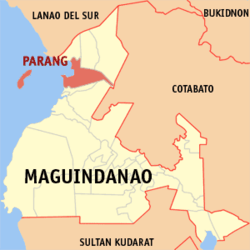Parang, Maguindanao
| Parang | |
|---|---|
| Municipality | |
 Map of Maguindanao showing the location of Parang | |
.svg.png) Parang Location within the Philippines | |
| Coordinates: 7°20′0″N 124°19′0″E / 7.33333°N 124.31667°ECoordinates: 7°20′0″N 124°19′0″E / 7.33333°N 124.31667°E | |
| Country |
|
| Region | Autonomous Region in Muslim Mindanao (ARMM) |
| Province | Maguindanao |
| Founded | August 18, 1947 |
| Barangays | 25 |
| Government[1] | |
| • Mayor | Ibrahim P. Ibay |
| Area | |
| • Total | 850.78 km2 (328.49 sq mi) |
| Population (2010) | |
| • Total | 73,328 |
| • Density | 86/km2 (220/sq mi) |
| Time zone | PST (UTC+8) |
| ZIP code | 9604 |
| Dialing code | +63 (0)64 |
| Income class | 1st |
Parang is a 1st class municipality in the province of Maguindanao, Philippines. According to the 2010 census, it has a population of 73,328 people in 20,449 households.
It is bordered to the north by Barira and Matanog, on the east by Buldon, and on the south is Sultan Kudarat. It was created on August 18, 1947, through Executive Order No. 82.
The town was part of the province of Shariff Kabunsuan from October 2006 until its nullification by the Supreme Court in July 2008.
Barangays
Parang is politically subdivided into 25 barangays.
- Bongo Island (Litayen)
- Campo Islam
- Cotongan
- Datu Macarimbang Biruar
- Gadungan
- Gadunganpedpandaran
- Guiday T. Biruar
- Gumagadong Calawag
- Kabuan
- Landasan (Sarmiento)
- Limbayan
- Macasandag
- Magsaysay
- Making
- Manion
- Moro Point
- Nituan
- Orandang
- Pinantao
- Poblacion
- Poblacion II
- Polloc
- Samberen
- Tagudtongan
- Tuca-Maror
Demographics
| Population census of Parang | ||
|---|---|---|
| Year | Pop. | ±% p.a. |
| 1990 | 55,355 | — |
| 1995 | 49,562 | −2.05% |
| 2000 | 60,935 | +4.53% |
| 2007 | 102,247 | +7.40% |
| 2010 | 73,328 | −11.40% |
| Source: National Statistics Office[2] | ||
Tourism
A cultural festival is held every August 18 in commemoration of the founding anniversary of Parang. Events are organized by the municipal government with the participation of various stakeholders
Tourist attractions in Parang include:
- Golf course in Camp S.K Pendatun
- Zone Beach
- Punta Beach
- White Sand Beach in Limbayan, Bonggo Island
- Molina-Munoz Farm Resort
- Fruit Bats Sanctuary
- Bacolod street
- Simento white camp
Infrastructure
Transportation
Major sea cargo vessels connect Polloc Port to Manila and other Philippine cities.
Tricycles are the main modes of public transport in the municipality. Several shuttle vans and PUJs provide regular trips to Cotabato City and other municipalities.
Health
- 1 District Hospital
- 1 Rural Health Unit
- 1 Private Hospital
- 1 Medical/Dental Hospital(PNP)
- 1 Medical Diagnostic Laboratory
Utilities
Magelco (Maguindanao Electric Cooperative, Inc.) provides electric power to the locality. Inland barangays use solar power as installed by our donor agencies.
Education
- Tertiary: 3 private schools
- Secondary: 5 public schools;3 private schools
- Elementary: 14 public schools;4 private schools
- Primary: 14 public schools
- Pre-School: 2 public schools;5 private schools
References
- ↑ "Official City/Municipal 2013 Election Results". Intramuros, Manila, Philippines: Commission on Elections (COMELEC). 1 July 2013. Retrieved 5 September 2013.
- ↑ "Total Population by Province, City, Municipality and Barangay: as of May 1, 2010". 2010 Census of Population and Housing. National Statistics Office. Retrieved 6 October 2013.
External links
- Philippine Standard Geographic Code
- Philippine Census Information
- Local Governance Performance Management System
 |
Matanog / Barira | Buldon |  | |
| Sugut Bay Illana Bay |
|
|||
| ||||
| | ||||
| Sultan Mastura / Sultan Kudarat | Pigcawayan, Cotabato |